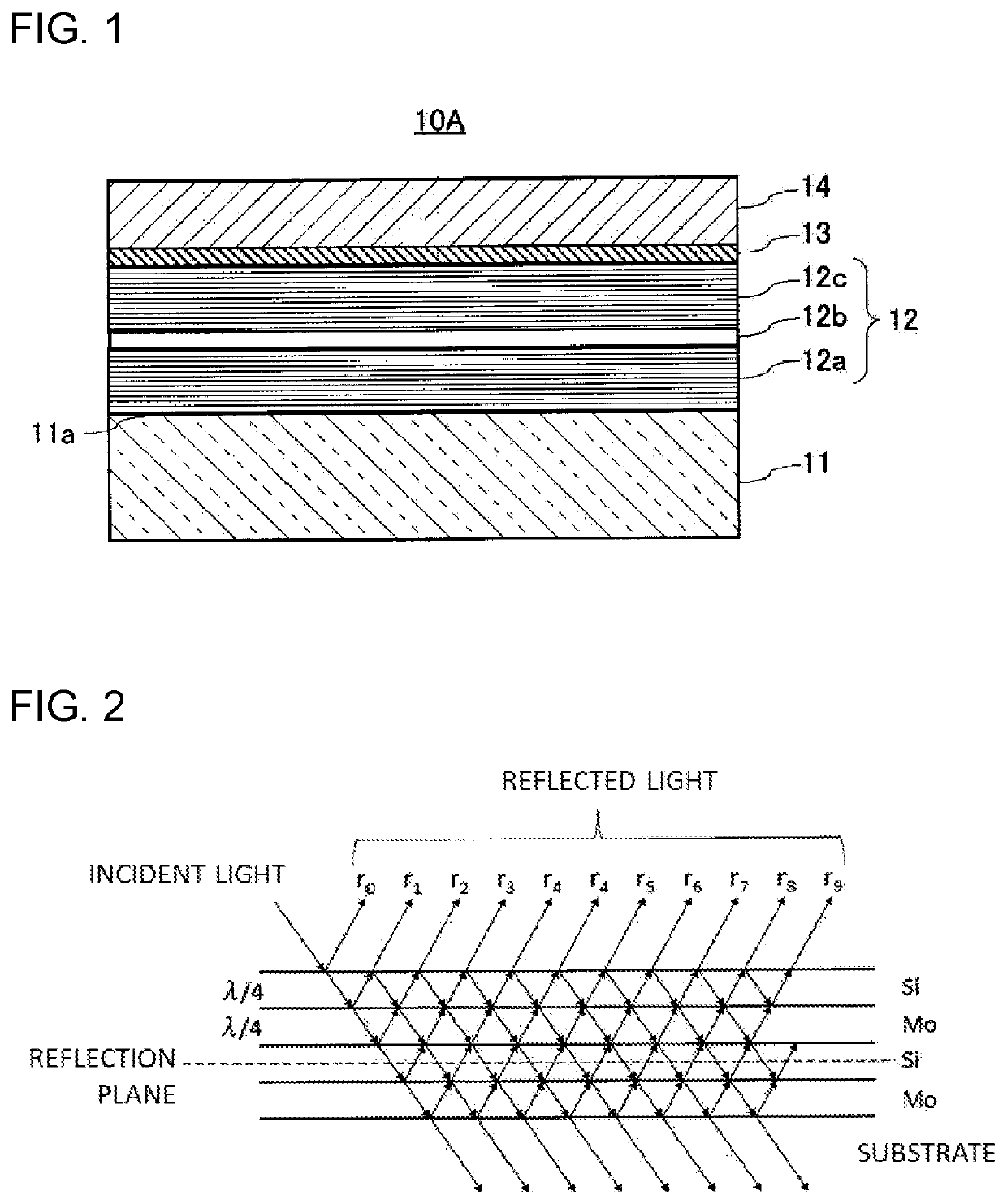Reflective mask blank, reflective mask, and process for producing reflective mask blank
a technology of reflective masks and mask blanks, applied in the field of reflective mask blanks and reflective masks, can solve the problems of telecentricity errors, the position of the image undesirably shifting in a horizontal direction, and the dioptric system used in conventional exposure techniques cannot be used therewith, so as to reduce the effect of mask 3d effects
- Summary
- Abstract
- Description
- Claims
- Application Information
AI Technical Summary
Benefits of technology
Problems solved by technology
Method used
Image
Examples
example 1
[0136]A reflective mask blank 10D is shown in FIG. 13. The reflective mask blank 10D includes a reflective layer 12 having no phase inversion layer 12b therein.
(Production of Reflective Mask Blank)
[0137]As a substrate 11 for deposition, an SiO2—TiO2 glass substrate (outer shape, about 152-mm square; thickness, about 6.3 mm) was used. This glass substrate had a coefficient of thermal expansion of 0.02×10−7 / ° C. or less. The glass substrate was polished to make a surface thereof flat and have a surface roughness of 0.15 nm or less in terms of root-mean-square roughness Rq and a flatness of 100 nm or less. A Cr layer having a thickness of about 100 nm was deposited on the back surface of the glass substrate by magnetron sputtering, thereby forming a backside electroconductive layer 16 for electrostatic chucking. The Cr layer had a sheet resistance value of about 100 Ω / □.
[0138]After the deposition of the backside electroconductive layer 16 on the back surface of the substrate 11, an Si ...
example 2
[0145]In this Example, the reflective mask blank 10C shown in FIG. 9 is produced. The reflective mask blank 10C includes a reflective layer 12 having a phase inversion layer 12b therein. The reflective layer 12 is configured by superposing a lower multilayer film 12a, the phase inversion layer 12b, and an upper multilayer film 12c in this order from the substrate 11 side.
(Production of Reflective Mask Blank)
[0146]This Example differs from Example 1 in the method for forming the reflective layer 12. A substrate 11, a backside electroconductive layer 16, a protective layer 13, and an absorbent layer 14 were produced by the same methods as in Example 1.
[0147]After the deposition of the backside electroconductive layer 16 on the back surface of the substrate 11, an Si film and an Mo film were alternately deposited repeatedly over 15 cycles on the front surface of the substrate 11 by ion-beam sputtering. The film thickness of each Si film was about 4.0 nm and the film thickness of each M...
example 3
[0157]In this Example, the reflective mask blank 10C shown in FIG. 9 is produced as in Example 2. This Example differs from Example 2 in the number of layers of the lower multilayer film 12a, the number of layers Ntop of the upper multilayer film 12c, and the total number of layers NML of the reflective film 12.
(Production of Reflective Mask Blank)
[0158]After a backside electroconductive layer 16 had been deposited on the back surface of a substrate 11, an Si film and an Mo film were alternately deposited repeatedly over 30 cycles on the front surface of the substrate 11 by ion-beam sputtering. The film thickness of each Si film was about 4.0 nm and the film thickness of each Mo film was about 3.0 nm. Thus, a lower multilayer film 12a having an overall film thickness of about 210 nm ((4.0 nm of Si film)+(3.0 nm of Mo film)×30) was formed.
[0159]The uppermost surface of the lower multilayer film 12a was an Mo film. An Si film serving as a phase inversion layer 12b was deposited thereo...
PUM
| Property | Measurement | Unit |
|---|---|---|
| thickness | aaaaa | aaaaa |
| wavelengths | aaaaa | aaaaa |
| wavelength | aaaaa | aaaaa |
Abstract
Description
Claims
Application Information
 Login to View More
Login to View More - R&D
- Intellectual Property
- Life Sciences
- Materials
- Tech Scout
- Unparalleled Data Quality
- Higher Quality Content
- 60% Fewer Hallucinations
Browse by: Latest US Patents, China's latest patents, Technical Efficacy Thesaurus, Application Domain, Technology Topic, Popular Technical Reports.
© 2025 PatSnap. All rights reserved.Legal|Privacy policy|Modern Slavery Act Transparency Statement|Sitemap|About US| Contact US: help@patsnap.com



